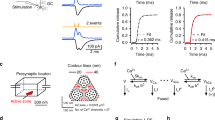Abstract
Although vesicle depletion contributes to short-term depression, several studies have reported that the release probability can be transiently depressed even if an action potential fails to evoke release. Here we argue that stochastic fluctuation in the release machinery can give rise to apparent release-independent depression as a result of sampling bias. The relationship between this apparent depression and the interstimulus interval provides a window on the kinetics of state transitions of the release apparatus.


Similar content being viewed by others
References
Zucker, R.S. & Regehr, W.G. Annu. Rev. Physiol. 64, 355–405 (2002).
Dobrunz, L.E., Huang, E.P. & Stevens, C.F. Proc. Natl. Acad. Sci. USA 94, 14843–14847 (1997).
Thomson, A.M. & Bannister, A.P. J. Physiol. (Lond.) 519, 57–70 (1999).
Brody, D.L. & Yue, D.T. J. Neurosci. 20, 2480–2494 (2000).
Hanse, E. & Gustafsson, B. J. Physiol. (Lond.) 531, 481–493 (2001).
Hanse, E. & Gustafsson, B. J. Neurosci. 21, 8362–8369 (2001).
Schneggenburger, R. & Neher, E. Curr. Opin. Neurobiol. 15, 266–274 (2005).
Sudhof, T.C. Annu. Rev. Neurosci. 27, 509–547 (2004).
Finley, M.F., Patel, S.M., Madison, D.V. & Scheller, R.H. J. Neurosci. 22, 1266–1272 (2002).
Hu, K. et al. Nature 415, 646–650 (2002).
Alle, H. & Geiger, J.R. Science 311, 1290–1293 (2006).
Shu, Y., Hasenstaub, A., Duque, A., Yu, Y. & McCormick, D.A. Nature 441, 761–765 (2006).
Rusakov, D.A. & Fine, A. Neuron 37, 287–297 (2003).
Acknowledgements
We are grateful to R. Scott and C. Henneberger for comments. Supported by the Medical Research Council, the Wellcome Trust and the European Commission (Eurohead, LSHM-CT-2004-504837).
Author information
Authors and Affiliations
Corresponding author
Ethics declarations
Competing interests
The authors declare no competing financial interests.
Supplementary information
Rights and permissions
About this article
Cite this article
Volynski, K., Rusakov, D. & Kullmann, D. Presynaptic fluctuations and release-independent depression. Nat Neurosci 9, 1091–1093 (2006). https://doi.org/10.1038/nn1746
Received:
Accepted:
Published:
Issue Date:
DOI: https://doi.org/10.1038/nn1746
- Springer Nature America, Inc.
This article is cited by
-
Multiplex imaging relates quantal glutamate release to presynaptic Ca2+ homeostasis at multiple synapses in situ
Nature Communications (2019)
-
Hybrid Markov-mass action law model for cell activation by rare binding events: Application to calcium induced vesicular release at neuronal synapses
Scientific Reports (2016)





